- Table of Content
- 1.A filament's b...
- 2.STCE at the Su...
- 3.Review of sola...
- 4.Review of geom...
- 5.The Internatio...
- 6.PROBA2 Observa...
- 7.Geomagnetic Ob...
- 8.The SIDC Space...
- 9.Action!
2. STCE at the Summer Space Festival
3. Review of solar activity
4. Review of geomagnetic activity
5. The International Sunspot Index by SILSO
6. PROBA2 Observations
7. Geomagnetic Observations in Belgium
8. The SIDC Space Weather Briefing
9. Action!
A filament's bright rim
Solar filaments are clouds of charged particles ("plasma") above the solar surface squeezed between magnetic regions of opposite polarity. Being cooler and denser than the plasma underneath and their surroundings, they appear as dark lines when seen on the solar disk and as bright blobs when seen near the solar limb (then they are called "prominences"). Special filters are required to observe these features, and one such a filter is the Hydrogen-alpha (H-alpha) line in the red part of the solar spectrum at 656.3nm.
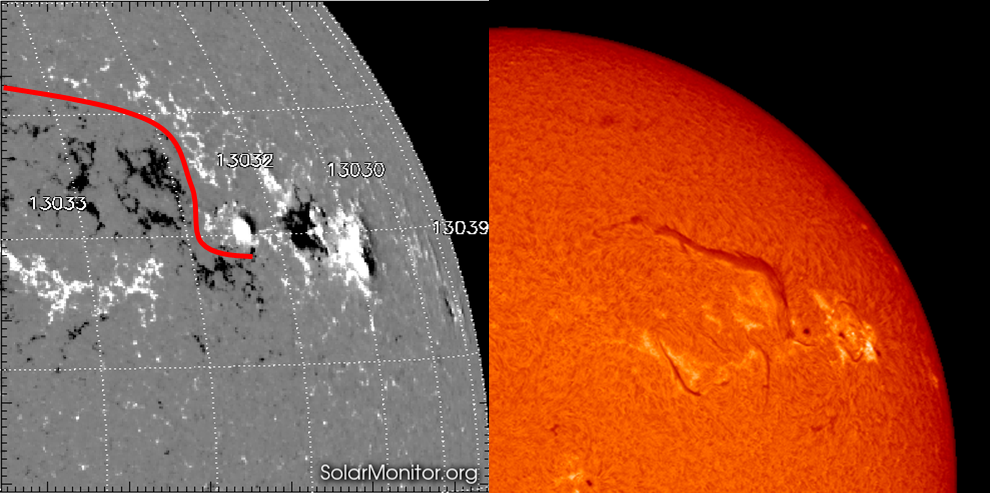
From 15 June onwards, a filament started to develop in the trailing portion of the sunspot complex that has been determining solar activity since mid-April. Starting south of NOAA 13032's main spot, it stretched itself all the way up into the northeastern direction. The image above to the right shows the filament late on 19 June in H-alpha (a colorized image from the GONG network: https://gong.nso.edu/), while the annotated magnetogram (SDO/HMI: https://sdo.gsfc.nasa.gov/data/aiahmi/) on the left proxies the location of the filament as it meanders through the areas of opposite polarity. White represents positive magnetic polarity (magnetic field (MF) lines coming out of the Sun), black represents negative polarity (MF lines returning to the Sun). The H-alpha images below show the evolution of the filament on 16, 18, 20 and 22 June.

The filament's length quickly grew from a few degrees on 15 June to over 30 degrees by 20 June, corresponding to a length of nearly 400.000 km which is the equivalent of the average Earth-Moon distance (384.400 km). The bright rim that can be seen at the base of the filament (annotated image below) is genuine and not an instrumental effect (Heinzel et al. 1995: https://ui.adsabs.harvard.edu/abs/1995SoPh..160...19H/abstract ). Bright rims are known for over 100 years now and are an integral part of the filament. They are most likely due to radiation diffusion inside the filament as it is irradiated from below. The resulting contrast has a close analogy in the Earth's atmosphere, when clouds observed at sunrise or sunset and irradiated from one side have a much higher brightness on that side compared to the other side. The intensity of the rim's brightness depends on various factors such as the orientation in the filament, the mass of the filament, its location on the solar disk, the height above the solar surface, and the presence of nearby features such as plages. This also explains why a large number of filaments do not show a bright rim.
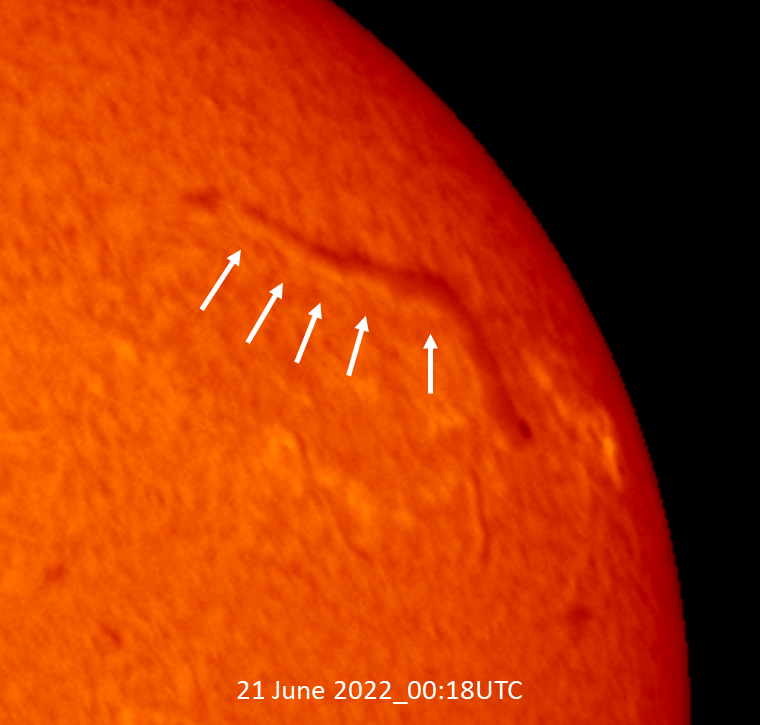
Long filaments are known to eventually erupt, as the surrounding magnetic fields usually become unstable at some point. In this case, the filament rounded the northwest solar limb uneventfully. The imagery below is a combination of a PROBA2/SWAP (https://proba2.sidc.be/) image showing the Sun at temperatures near 1 million degrees (extreme ultraviolet) overlaid on an H-alpha image. As the filament is much denser and has a much lower temperature (about 10.000 degrees) than the corona, it shows as a dark "wall" at the northwest limb in this composite. The height of the filament was about 35.000 km, similar to the circumference of the Earth. These quiescent filaments may live a long time, and so we may see it again within 2 weeks when it will have finished its farside transit. Clips are available in the online version of this newsitem at https://www.stce.be/news/597/welcome.html
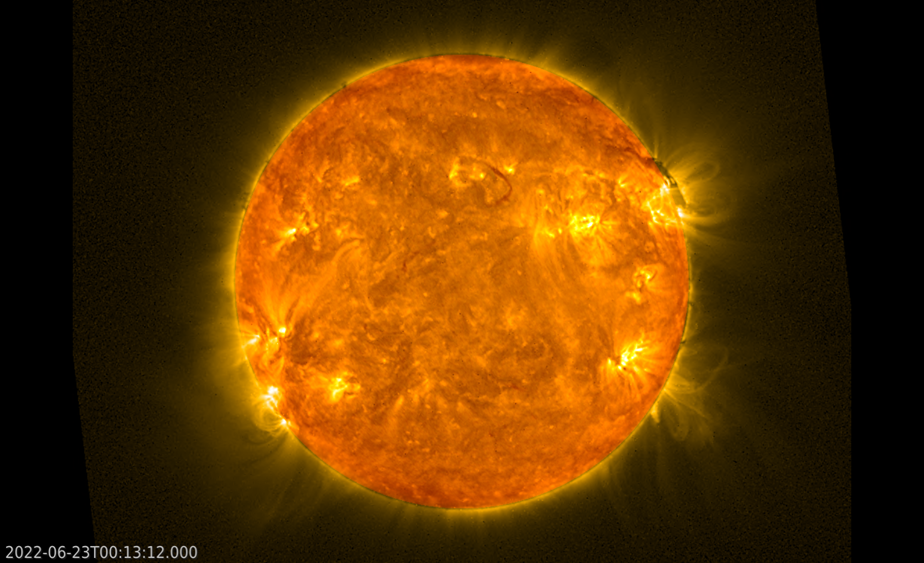
STCE at the Summer Space Festival
The Summer Space Festival took place on 24 and 25 June, 2022 in Brussels. This event was founded by a group of young space enthusiasts, wishing to inspire the public, raise awareness of space activities and promote local space initiatives.
The days were filled with accessible space talks, panel discussions, workshops, exhibits and fun family activities. The STCE presented two talks: one on the northern lights and one on space weather.
https://summerspacefestival.fr/en
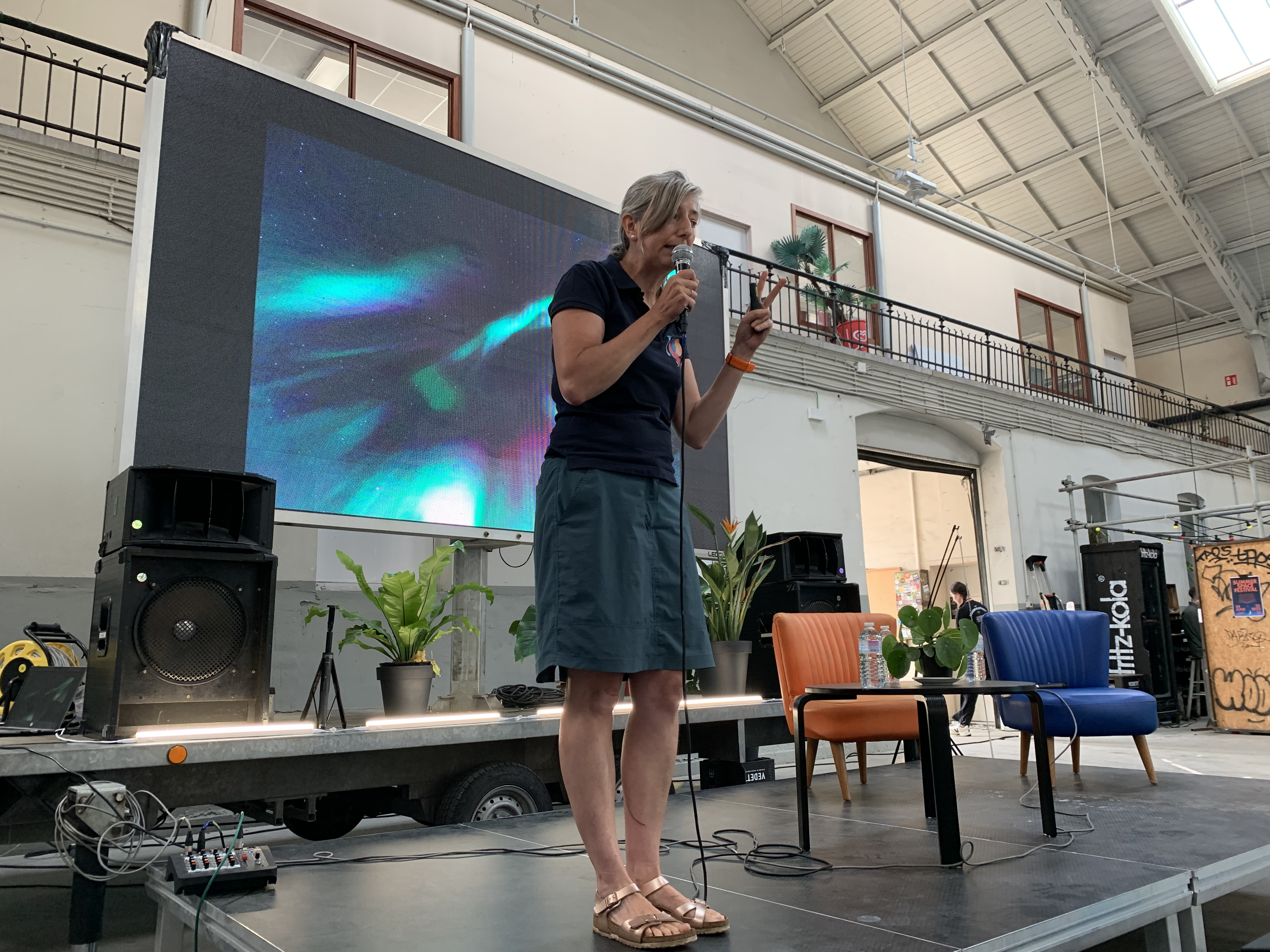
Review of solar activity
Electromagnetic radiation: Flares
Over the past week, we observed several active regions on the visible side of the solar disc as seen from Earth. The solar flaring activity was low with several C-class flares. The larger one was a C5.7 flare from Catania sunspot group 53 (NOAA active region 3038) on June 20 at 06:18 UTC.
Solar wind: Coronal Mass Ejections
We detected no Earth-directed Coronal Mass Ejections (CMEs) in the available coronagraph images over the past week. A partial halo CME was detected by Cactus tool (the software package for 'Computer Aided CME Tracking') on June 26, around 03:30 UTC with an average plane-of-sky velocity of around 680 km/s. The CME was related to an on-disc filament eruption in the south-west quadrant and its main direction was south-west.
Particle radiation: protons and electrons
The greater than 10 MeV proton flux was at nominal levels over the past week. The greater than 2 MeV electron flux exceeded the 1000 pfu alert threshold in response to the high solar wind speed associated with the coronal hole in the past week. The electron fluence was at normal to moderate levels.
Review of geomagnetic activity
The solar wind parameters measured in the vicinity of Earth were under the influence of fast wind streams from several coronal holes.
In the beginning of the week, the wind speed was elevated (up to 629 km/s) due to the influence of the fast solar wind speed stream associated with the equatorial coronal hole (positive polarity) that reached the central meridian last week on Jun 12. Then, close to the end of the week, the solar wind parameters were again elevated with the arrival of the fast solar wind coming from coronal holes (negative polarity) with the wind speed increasing up to 655 km/s.
The geomagnetic conditions were mostly unsettled the entire week, with some active conditions (local K-Belgium = 5) and minor storm (NOAA Kp = 5) in response to the arrival of the high-speed stream in the end of the week, and the prolonged negative values of the Bz component of the interplanetary magnetic field.
The International Sunspot Index by SILSO
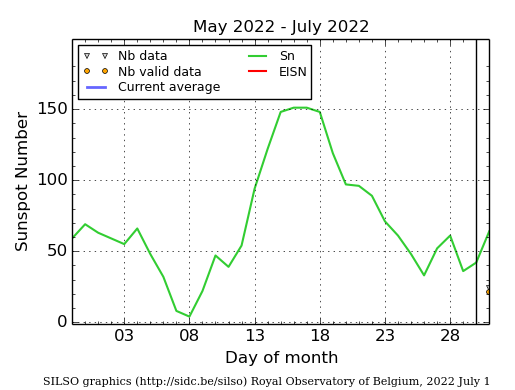
The daily Estimated International Sunspot Number (EISN, red curve with shaded error) derived by a simplified method from real-time data from the worldwide SILSO network. It extends the official Sunspot Number from the full processing of the preceding month (green line), a few days more than one solar rotation. The horizontal blue line shows the current monthly average. The yellow dots give the number of stations that provided valid data. Valid data are used to calculate the EISN. The triangle gives the number of stations providing data. When a triangle and a yellow dot coincide, it means that all the data is used to calculate the EISN of that day.
PROBA2 Observations
Solar Activity
Solar flare activity was low this week.
In order to view the activity of this week in more detail, we suggest to go to the following website from which all the daily (normal and difference) movies can be accessed: https://proba2.oma.be/ssa
This page also lists the recorded flaring events.
A weekly overview movie (SWAP week 639) can be found here: https://proba2.sidc.be/swap/data/mpg/movies/weekly_movies/weekly_movie_2022_06_20.mp4
Details about some of this week's events can be found further below.
If any of the linked movies are unavailable they can be found in the P2SC movie repository here https://proba2.oma.be/swap/data/mpg/movies/.
Thursday 23 June
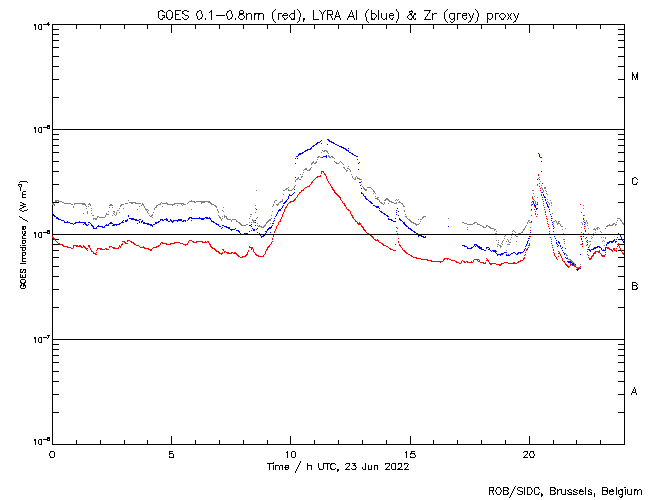
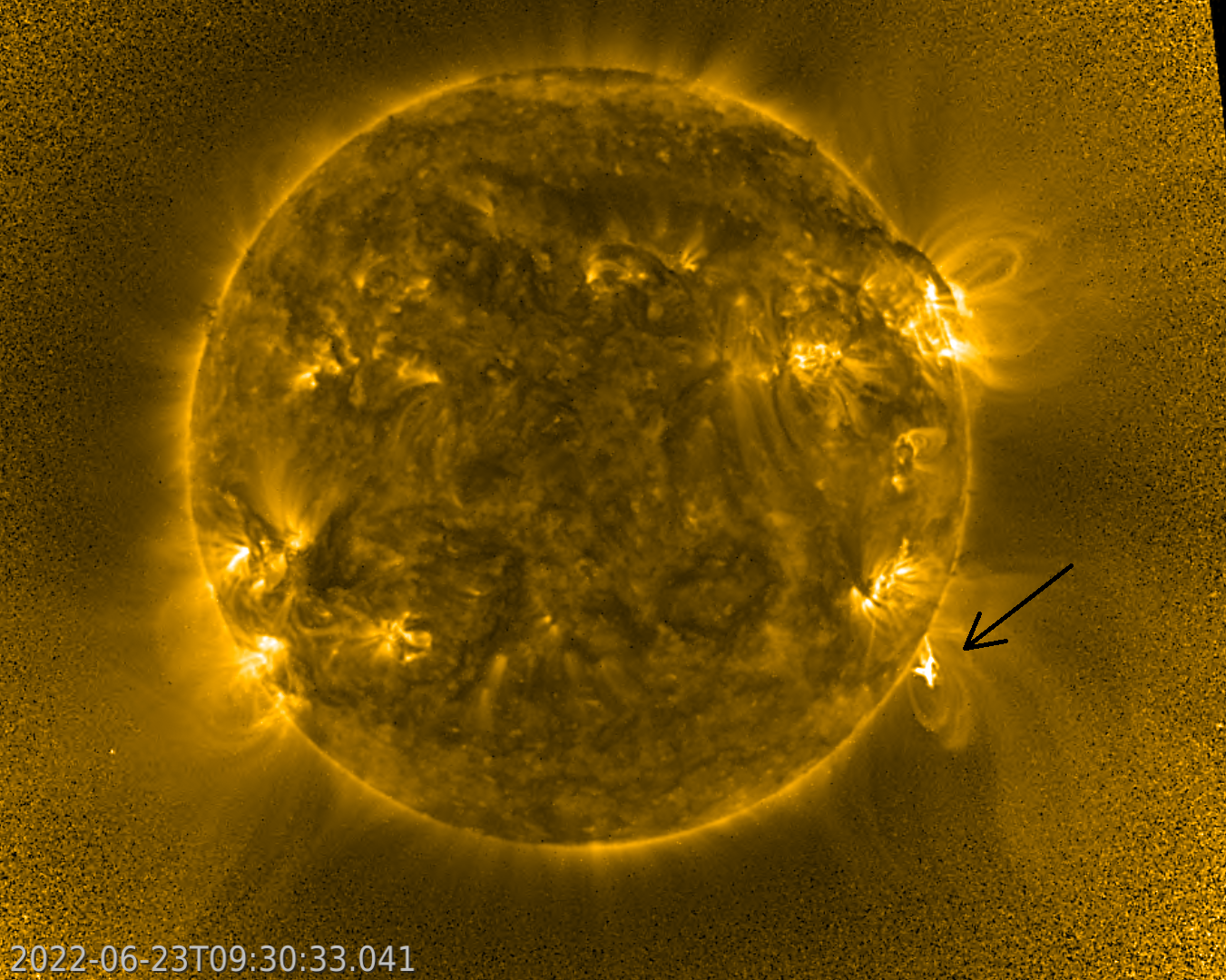
A very peculiar, gradual and confined flare, a long duration C4.0, is visible in the LYRA and SWAP images above. It was associated with a failed filament eruption seen on the western limb of the Sun, and it peaked at 08:49 UT on 2022-Jun-23.
Find a SWAP movie of the event here: https://proba2.sidc.be/swap/movies/20220623_swap_movie.mp4.
Sunday 26 June
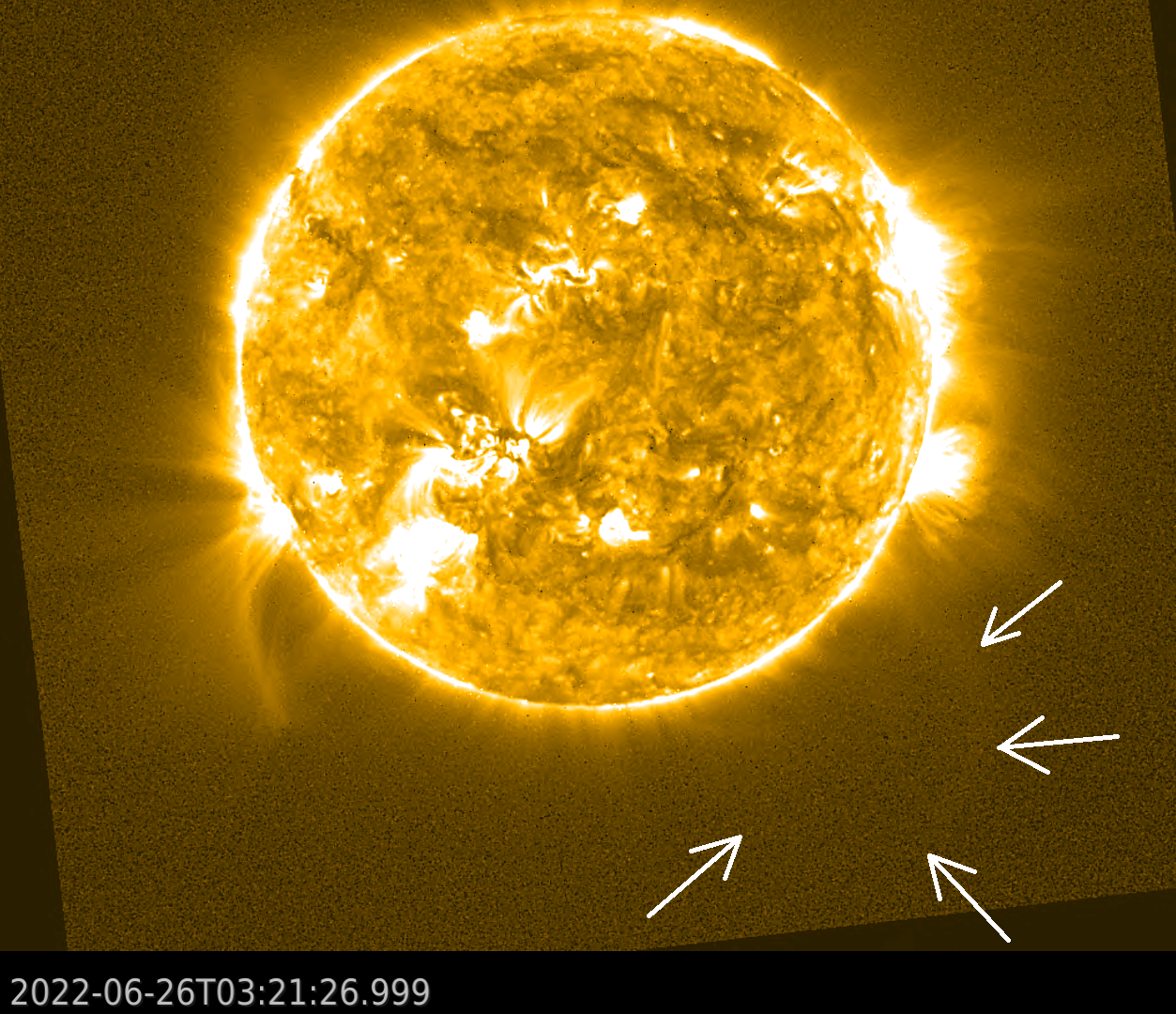
The largest CME of the week is still visible in SWAP observations at heights of more than 2RS. The front of this partial halo CME can be seen in the south-west quadrant and is indicated by arrows in the above SWAP observation, taken at 03:21 UT on 2022-Jun-26.
Find a SWAP movie of the event here: https://proba2.sidc.be/swap/movies/20220626_swap_movie.mp4.
Geomagnetic Observations in Belgium
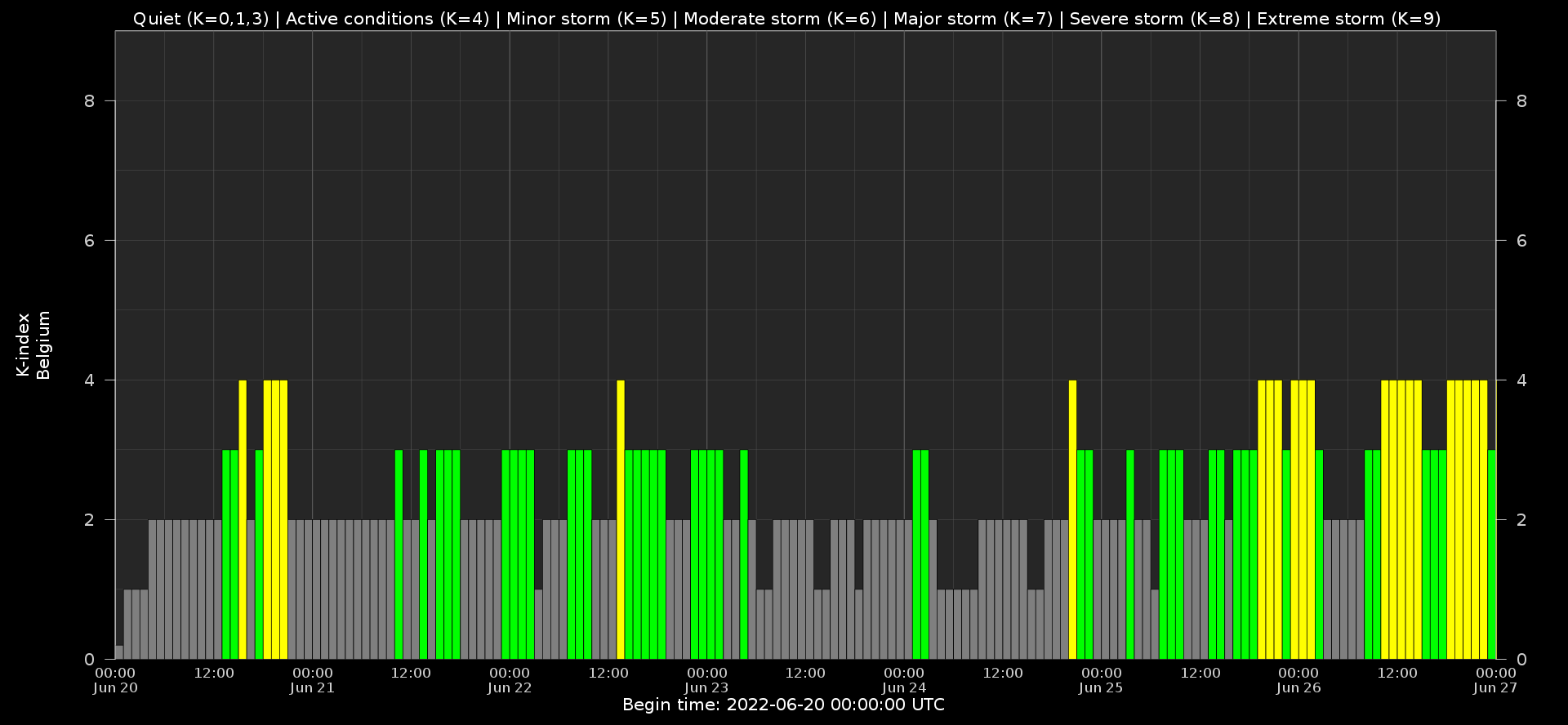
Local K-type magnetic activity index for Belgium based on data from Dourbes (DOU) and Manhay (MAB). Comparing the data from both measurement stations allows to reliably remove outliers from the magnetic data. At the same time the operational service availability is improved: whenever data from one observatory is not available, the single-station index obtained from the other can be used as a fallback system.
Both the two-station index and the single station indices are available here: http://ionosphere.meteo.be/geomagnetism/K_BEL/
The SIDC Space Weather Briefing
The Space Weather Briefing presented by the SIDC (https://www.sidc.be) forecaster on duty from June 20 to 26. It reflects in images and graphs what is written in the Solar and Geomagnetic Activity report: https://www.stce.be/briefings/20220627_SWbriefing.pdf
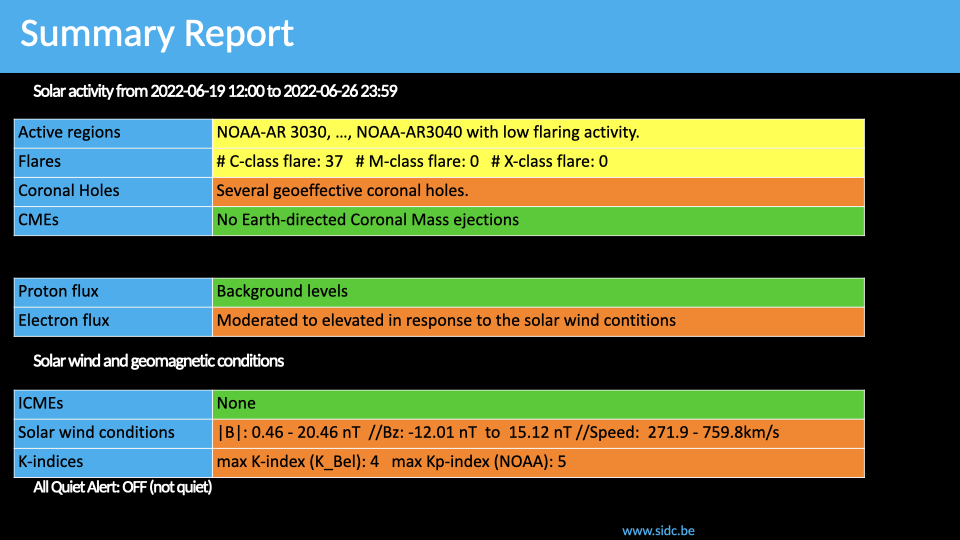
Action!
Check out our activity calendar: activities and encounters with the Sun-Space-Earth system and Space Weather as the main theme. We provide occasions to get submerged in our world through educational, informative and instructive activities.
If you want your event in our calendar, contact us: stce_coordination at stce.be
* July 3, Public Lecture on STCE's missions to the Sun, Cosmodrome, Genk, Belgium
* August 25, Public Lecture on Space Weather and Aviation, Astropolis, Oostende, Belgium
* September 24-25 Space Pole Open Days, Brussels, Belgium
* October 24-28, 18th European Space Weather Week, Zagreb, Croatia
* November 21-23, Space Weather Introductory Course - onsite, by the STCE, Brussels, Belgium
* December 5, 6, 8, 9, Space Weather Introductory Course - online, by the STCE, zoom
Check: https://www.stce.be/calendar
